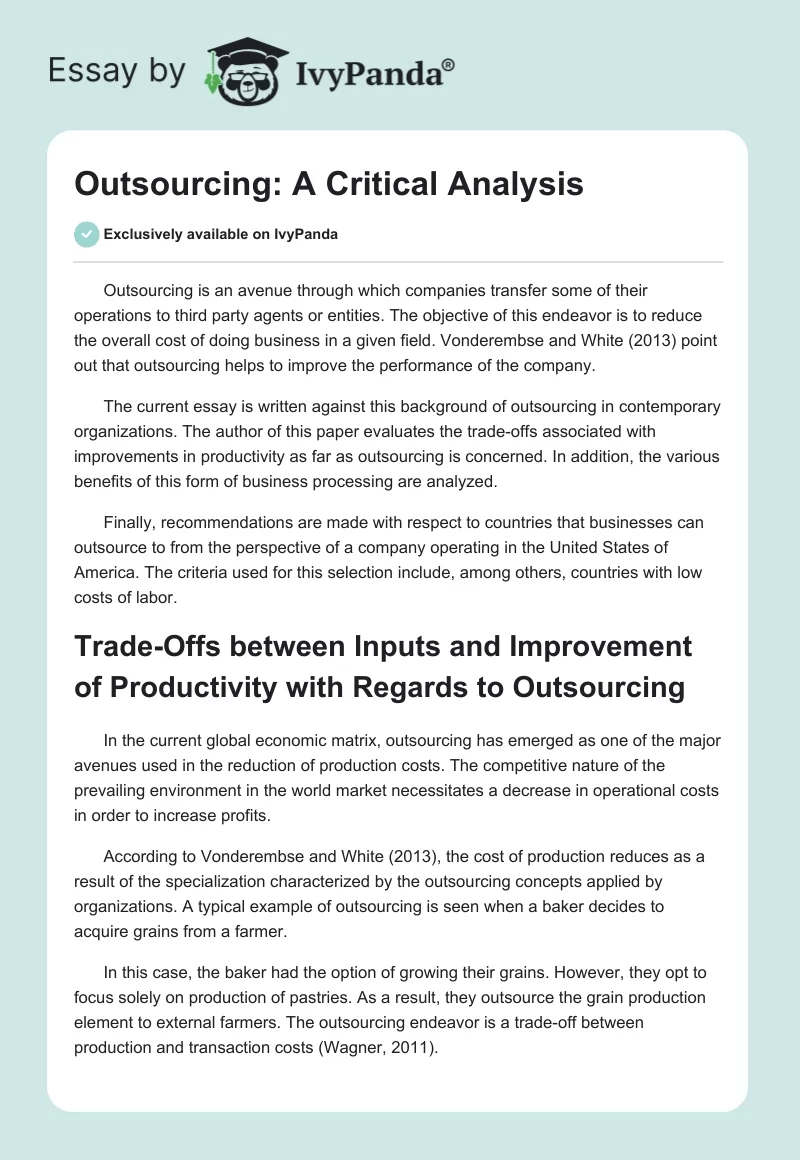Outsourcing is an avenue through which companies transfer some of their operations to third party agents or entities. The objective of this endeavor is to reduce the overall cost of doing business in a given field. Vonderembse and White (2013) point out that outsourcing helps to improve the performance of the company.
The current essay is written against this background of outsourcing in contemporary organizations. The author of this paper evaluates the trade-offs associated with improvements in productivity as far as outsourcing is concerned. In addition, the various benefits of this form of business processing are analyzed.
Finally, recommendations are made with respect to countries that businesses can outsource to from the perspective of a company operating in the United States of America. The criteria used for this selection include, among others, countries with low costs of labor.
Trade-Offs between Inputs and Improvement of Productivity with Regards to Outsourcing
In the current global economic matrix, outsourcing has emerged as one of the major avenues used in the reduction of production costs. The competitive nature of the prevailing environment in the world market necessitates a decrease in operational costs in order to increase profits.
According to Vonderembse and White (2013), the cost of production reduces as a result of the specialization characterized by the outsourcing concepts applied by organizations. A typical example of outsourcing is seen when a baker decides to acquire grains from a farmer.
In this case, the baker had the option of growing their grains. However, they opt to focus solely on production of pastries. As a result, they outsource the grain production element to external farmers. The outsourcing endeavor is a trade-off between production and transaction costs (Wagner, 2011).
A reduction in the cost of production is accompanied by an increase in transaction expenses.
Outsourcing often involves a third party. In this regard, the cost of production has a ripple effect on the transaction expenses incurred as a result of engaging the third agent. According to Vonderembse and White (2013), productivity is best realized when the expenses incurred in production are lower compared to the transaction costs.
Separately, the whole idea of outsourcing brings about displacement and loss of jobs. In this regard, improvements in productivity are realized at the expense of transaction costs and job displacements.
Advantages and Disadvantages of Outsourcing in Comparison to Production in the United States
As already mentioned, outsourcing is associated with a reduction in the costs of production. As a result, the company can increase the volume of goods produced.
Antras and Helpman (2004) evaluated this concept on the global arena and found that companies that outsourced to countries with low costs of labor tend to record improved performance given the increased volume of production.
The customer care element is an example of services that companies are outsourcing to other firms in places like India. In this regard, specialization helps to enhance the quality of the services provided.
The major disadvantage of outsourcing is the displacement of opportunities. To this end, companies are forced to lay off employees who are deemed as non-essential. According to Antras and Helpman (2004), organizations prefer to outsource their operations to countries with extremely low costs of labor.
Vonderembse and White (2013) argue that job displacement is justified by the need to reduce costs of production. However, there are cases where companies outsource to firms that have a poor record in relation to labor relations. In this regard, the outsourcing endeavor stands to diminish the gains made with regards to labor laws.
However, in the broader spectrum of business, outsourcing non-essential skills is relevant given the high costs of labor in the United States. The growth of Apple Inc. can be attributed to this concept.
Recommendations
As already mentioned, the benefits of outsourcing are realized when the overall cost of production is maintained at an absolute minimum. Vonderembse and White (2013) emphasize that the transaction costs should be reduced to ensure that the value of the outsourcing endeavor is realized.
In light of this, a number of recommendations are essential with respect to trade-offs, inputs, and global advantages of outsourcing.
Countries with low costs of labor are common places for outsourcing. In such markets, cost rationalization must be performed. According to Vonderembse and White (2013), this kind of rationalization is achieved by renegotiating fixed contracts. The move helps to reduce transaction costs.
Nations with low cost labor should also implement backward integration policies in the procurement of inputs. As a result, outsourcing firms are tasked with the responsibility of providing low cost solutions to the business challenges facing many companies.
Conclusion
Outsourcing is beneficial given that it leads to improved productivity. The specialization factor enhances the quality of the outsourced roles. For instance, manufacturing is effectively handled in countries like China and India where cost of production is low.
Additional research is needed to show how transaction costs can help improve outsourcing in general. Vonderembse and White (2013) point out that high transaction costs lead to reduced quality of products.
References
Antras, P., & Helpman, E. (2004). Global sourcing. Journal of Political Economy, 112, 552-580.
Vonderembse, M., & White, G. (2013). Operations management: Concepts, Methods, and Strategies. San Diego, CA: Bridgepoint Education, Inc.
Wagner, J. (2011). Off-shoring and firm performance: Self-selection, effects on performance or both?. Review of World Economics, 147, 217-247.


